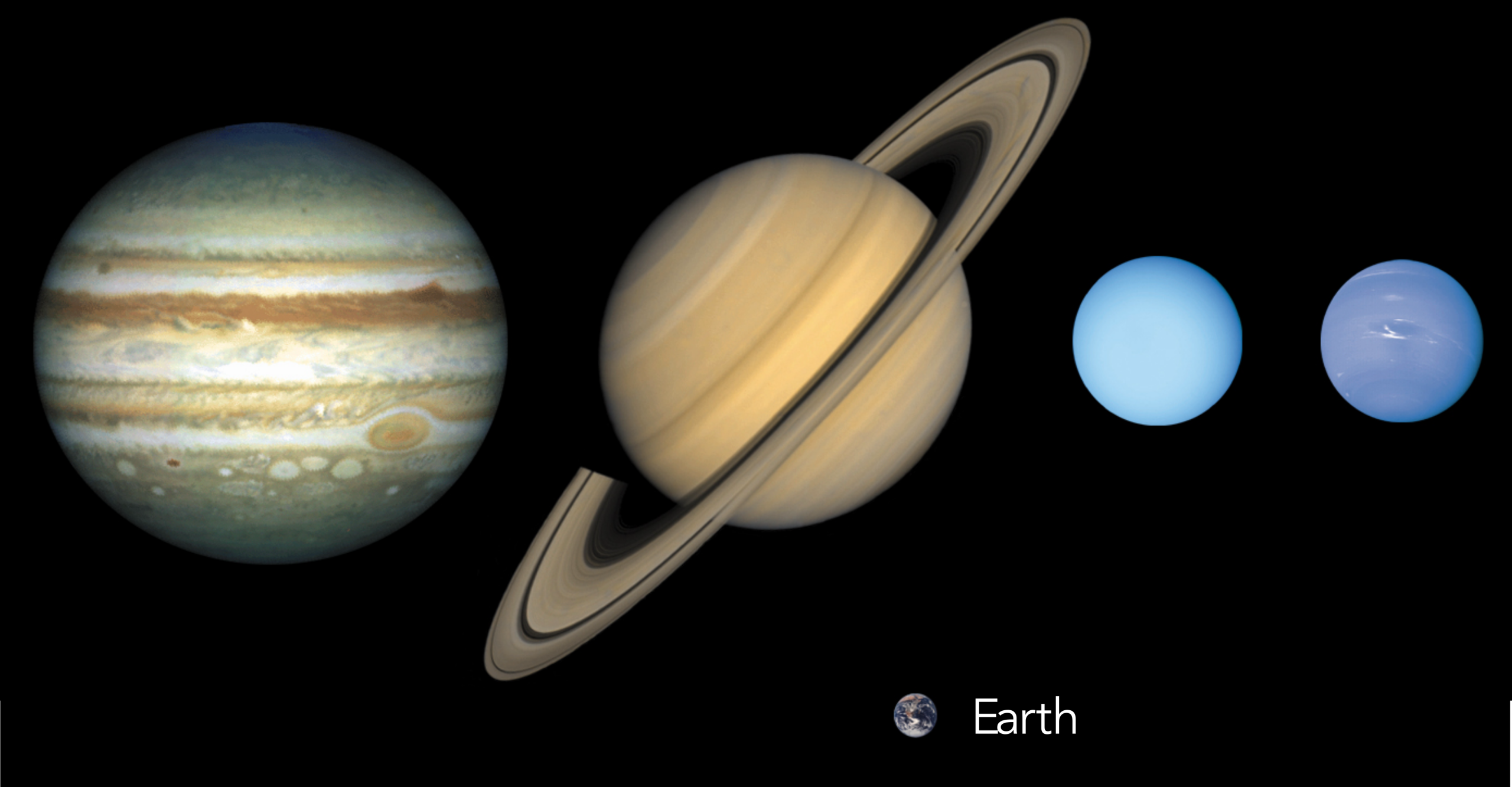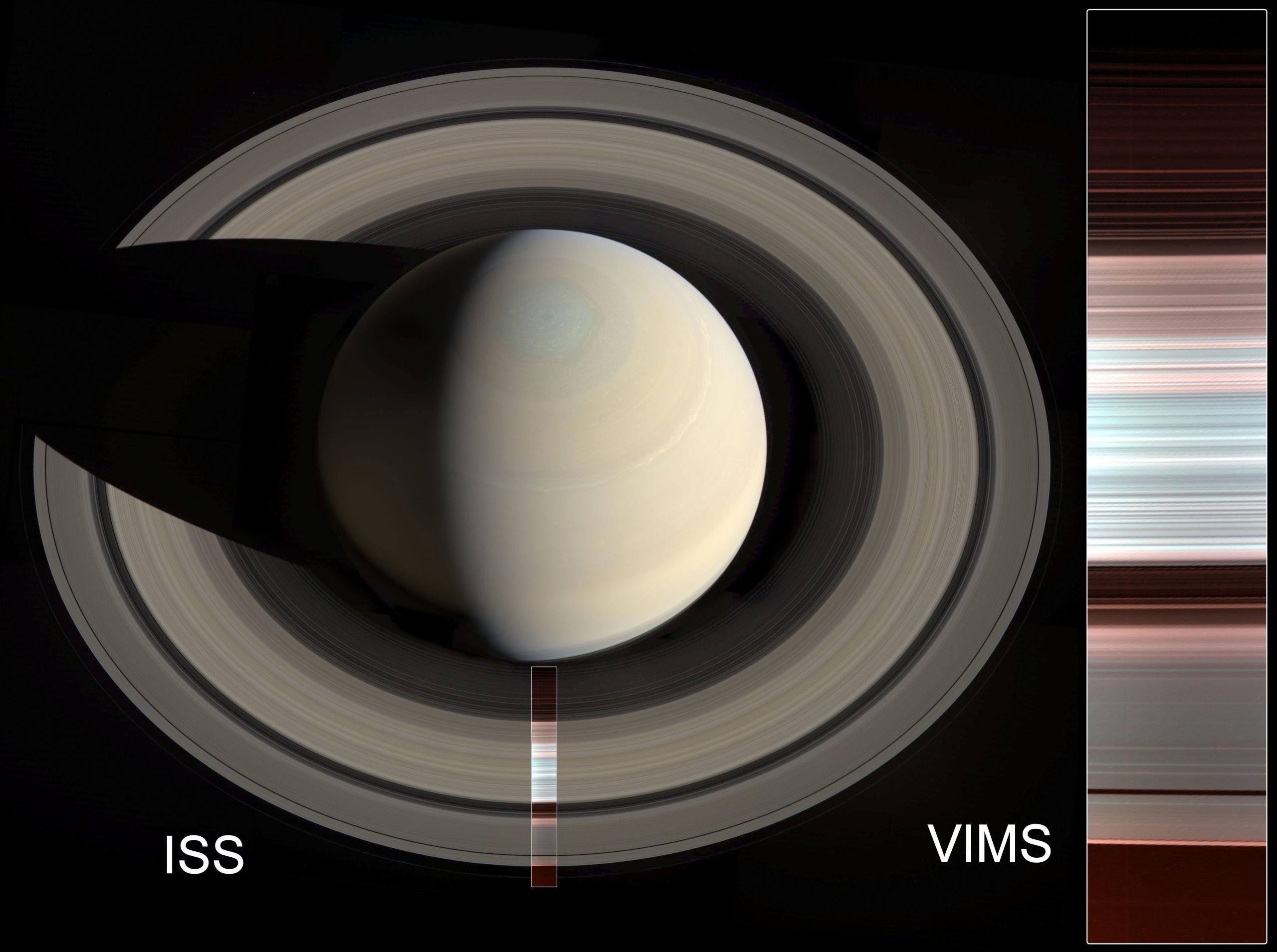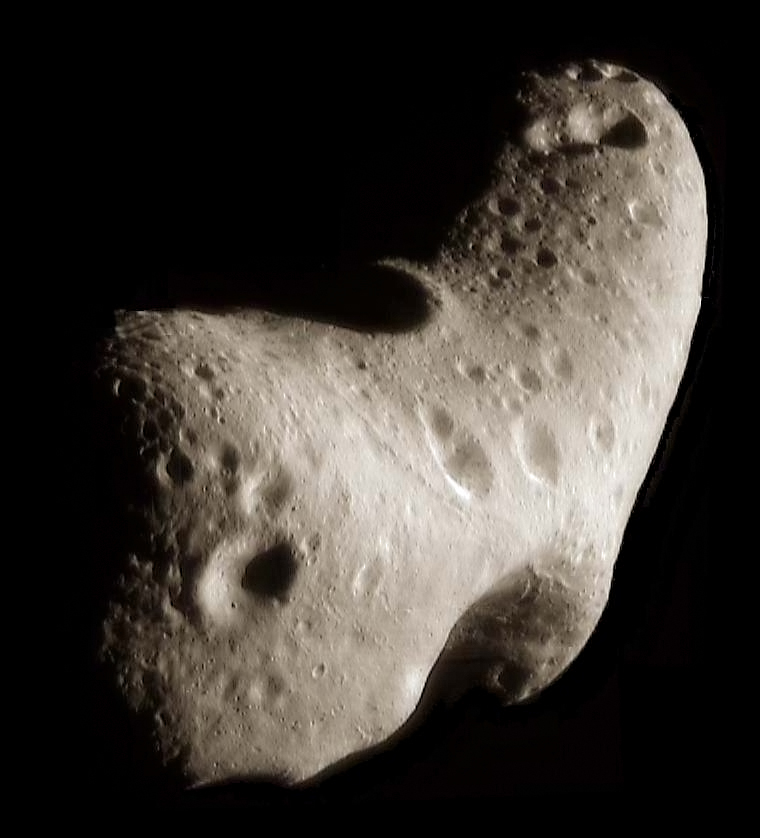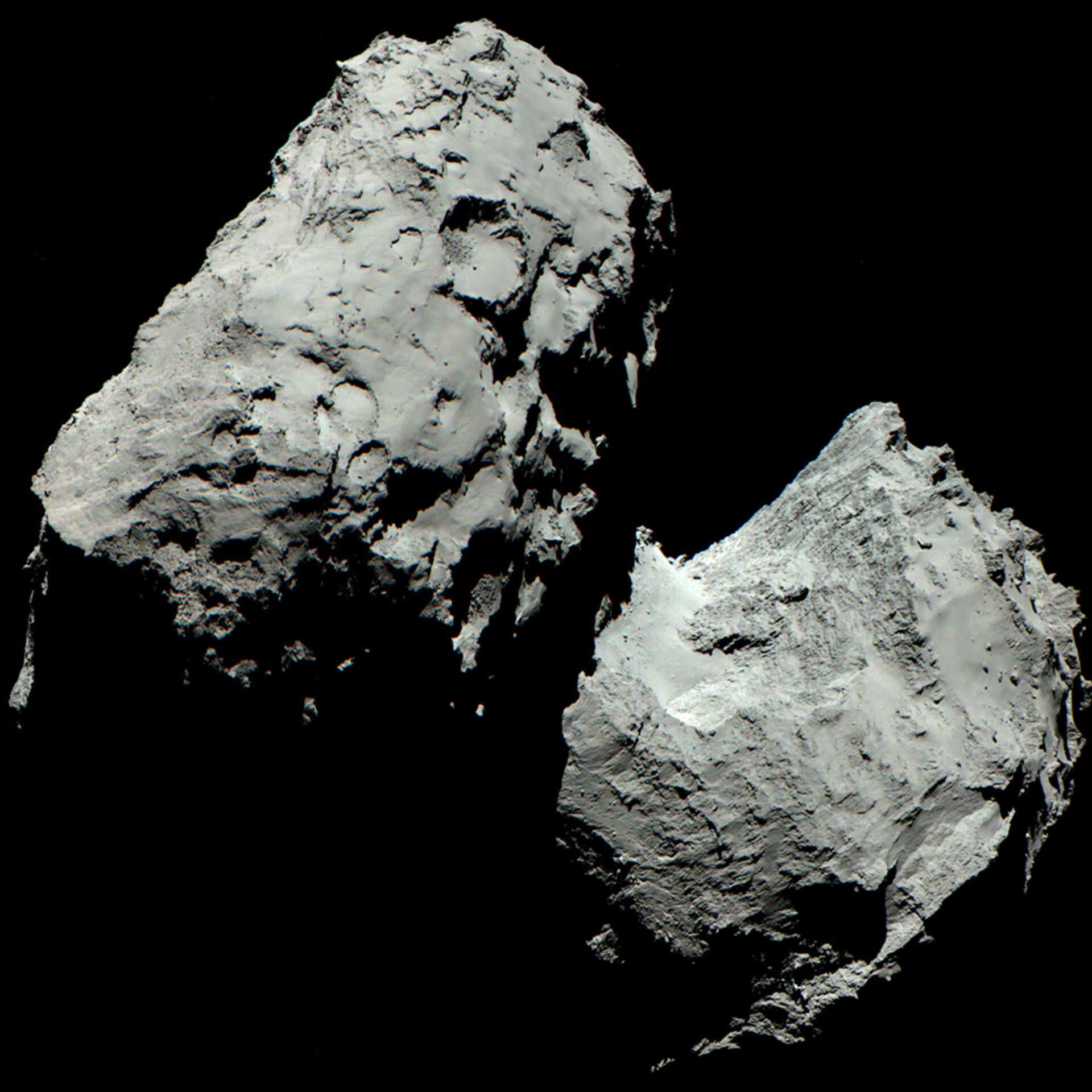1.4 Overview of Our Planetary System

Surrounding the Sun is a complex system of worlds with a wide range of conditions: eight major planets, many dwarf planets, hundreds of moons, and countless smaller objects including asteroids and comets. Thanks largely to visits by spacecraft, we can now envision the members of the solar system as other worlds like our own, each with its own chemical and geological history, and unique sights that interplanetary tourists may someday visit. Decades of observation and spacecraft exploration have revealed that most of the objects of the solar system formed together with the Sun about 4.5 billion years ago. They represent clumps of material that condensed from an enormous cloud of gas and dust. The central part of this cloud became the Sun, and a small fraction of the material in the outer parts eventually formed the other objects.
During the past 50 years, we have learned more about the Solar System than anyone imagined before the Space Age. Some have called these past few decades the “golden age of planetary exploration,” comparable to the golden age of exploration in the fifteenth century, when great sailing ships plied Earth’s oceans and humanity became familiar with our own planet’s surface. In addition to gathering information with powerful new telescopes, we have sent spacecraft directly to many members of our planetary system. With evocative names such as Voyager, Pioneer, Curiosity, and Pathfinder, our robot explorers have flown past, orbited, or landed on every planet, returning images and data that have dazzled both astronomers and the public. In the process, we have also investigated two dwarf planets, hundreds of fascinating moons, four ring systems, a dozen asteroids, and several comets (smaller members of our Solar System that we will discuss later).
Our probes have penetrated the atmospheres of Jupiter and Saturn and landed on the surfaces of Venus, Mars, our Moon, Saturn’s moon Titan, the asteroids Eros, Itokawa, Ryugu, and Bennu, and the comet Churyumov-Gerasimenko (usually referred to as 67P). Humans have set foot on the Moon and returned samples of its surface soil for laboratory analysis (Figure 1.15). We have flown a helicopter drone on Mars. We have even discovered other places in our Solar System that might be able to support some kind of life.
1.4.1 An Inventory
The Sun, a star that is brighter than about 80% of the stars in the Milky Way galaxy, is by far the most massive member of the Solar System, as shown in Table 1.1. It is an enormous ball about 1.4 million kilometers in diameter, with surface layers of incandescent gas and an interior temperature of millions of degrees. We are able to see the nearby planets in our skies only because they reflect the light of our local star, the Sun. If the planets were much farther away, the tiny amount of light they reflect would usually not be visible to us.
| Object | Percentage of Total Mass of Solar System |
| Sun | 99.80 |
| Jupiter | 0.10 |
| Comets | 0.0005–0.03 (estimate) |
| All other planets and dwarf planets | 0.04 |
| Moons and rings | 0.00005 |
| Asteroids | 0.000002 (estimate) |
| Comic dust | 0.0000001 (estimate) |
Most of the material of the planets in the Solar System is actually concentrated in the largest one, Jupiter, which is more massive than all the rest of the planets combined (Table 1.1). Astronomers were able to determine the masses of the planets centuries ago using Kepler’s laws of planetary motion and Newton’s law of gravity to measure the planets’ gravitational effects on one another or on moons that orbit them. Today, we make even more precise measurements of their masses by tracking their gravitational effects on the motion of spacecraft that pass near them.


Beside Earth, five other planets were known to the ancients—Mercury, Venus, Mars, Jupiter, and Saturn—and two were discovered after the invention of the telescope: Uranus and Neptune. A planet is defined as a body of significant size that orbits a star and does not produce its own light. (If a large body consistently produces its own light, it is then called a star.) Later in this class this definition will be modified a bit, but it is perfectly fine for now as we begin our voyage. The eight planets all revolve in the same direction around the Sun. They orbit in approximately the same plane which we call the ecliptic, like cars traveling on concentric tracks on a giant, flat racecourse. Each planet stays in its own “traffic lane,” following a nearly circular orbit about the Sun and obeying the “traffic” laws discovered by Galileo, Kepler, and Newton. Besides these planets, we have also been discovering smaller worlds beyond Neptune that are called trans-Neptunian objects or TNOs (Figure 1.16). The first to be found, in 1930, was Pluto, but others have been discovered during the twenty-first century. One of them, Eris, is about the same size as Pluto and has at least one moon (Pluto has five known moons). The largest TNOs are also classed as dwarf planets, as is the largest asteroid, Ceres. As of summer 2025, more than 5,000 of these TNOs have been discovered (both numbered and unnumbered objects), and one, called Arrokoth, was explored by the New Horizons spacecraft. The orbits these TNOs can be highly elliptical and tilted compared to the eight major planets.
Each of the planets and dwarf planets also rotates (spins) about an axis running through it, and in most cases, the direction of rotation is the same as the direction of revolution about the Sun. The exceptions are Venus, which rotates backward (that is, in a retrograde direction), and Uranus and Pluto, which also have strange rotations, each spinning about an axis tipped nearly on its side. We do not yet know the spin orientations of the dwarf planets Eris, Haumea, and Makemake.
The rotation rates of the eight planets have been measured as follows. Mercury has a day that lasts 1,408 Earth hours, while Venus has the longest day of any planet at 5,832 Earth hours. Earth and Mars have similar day lengths, with Earth taking 24 hours to complete one rotation and Mars taking 25 hours. The gas giant rotate much faster than the terrestrial planets, with Jupiter having the shortest day at just 10 Earth hours for one rotation. Saturn is slightly slower, with a day length of 11 Earth hours. The two outermost planets, Uranus and Neptune, have day lengths of 17 Earth hours and 16 Earth hours, respectively.

The four planets closest to the Sun (Mercury through Mars) are called the inner, or terrestrial, planets. Often, the Moon is also discussed as a part of this group, bringing the total of terrestrial objects to five (we generally call Earth’s satellite “the Moon,” with a capital M, and the other satellites “moons,” with lowercase m’s). The terrestrial planets are relatively small worlds, composed primarily of rock and metal. All of them have solid surfaces that bear the records of their geological histories in the forms of craters, mountains, canyons, and volcanoes (Figures 1.17 and 1.18).
Although the terrestrial planets share similar geological features, the size and abundance of these features vary on each planet. For instance, volcanic rock is present on all four inner planets, but Venus has the most volcanoes, with over 1,600 major ones and many smaller ones. In contrast, Mars has fewer than 20 named volcanoes, but it boasts the largest volcanoes in the Solar System, including Olympus Mons, the tallest of them all (Figure 1.18). Mars is also home to the largest canyon in the Solar System, the Valles Marineris, which stretches over 3,000 km in length, spans up to 600 km in width, and reaches depths of up to 8 km. By comparison, the Earth’s Grand Canyon in Arizona is 800 km long, 30 km across, and 1.8 km deep.

Earth is a nearly spherical planet about 13,000 kilometers in diameter. A space traveler entering our planetary system would easily distinguish Earth from the other planets by the large amount of liquid water that covers roughly two thirds of its surface. If the traveler had equipment to receive radio or television signals, or came close enough to see the lights of our cities at night, they would soon find signs that this watery planet has sentient life. Earth’s nearest astronomical neighbor is the Moon. Figure 1.19 shows Earth and the Moon drawn to scale on the same diagram. Notice how small we have to make these bodies to fit them on the page with the right scale. The Moon’s distance from Earth is about 30 times Earth’s diameter, or approximately 384,000 kilometers, and it takes about a month for the Moon to revolve around Earth. The Moon’s diameter is 3476 kilometers, about one fourth the size of Earth.
The next four planets (Jupiter through Neptune) are much larger and are composed primarily of lighter ices, liquids, and gases. We call these four the Jovian planets (after “Jove,” another name for Jupiter in mythology) or giant planets—a name they richly deserve (Figure 1.20). About 1,300 Earths could fit inside Jupiter, for example. These planets do not have solid surfaces on which future explorers might land. They are more like vast, spherical oceans with much smaller, dense cores.

Near the outer edge of the system lies Pluto, which was the first of the distant icy worlds to be discovered beyond Neptune. Pluto was visited by a spacecraft, the NASA New Horizons mission, in 2015 (Figure 1.21).

The outermost part of the Solar System is known as the Kuiper Belt, which is a scattering of rocky and icy bodies. Beyond that is the Oort cloud, a zone filled with small and dispersed ice traces. These two locations are where most comets form and continue to orbit, and objects found here have relatively irregular orbits compared to the rest of the Solar System. Pluto, formerly the ninth planet, is located in this region of space. The XXVI General Assembly of the International Astronomical Union (IAU) stripped Pluto of planetary status in 2006 because scientists discovered an object more massive than Pluto, named Eris. The IAU did not want to classify Eris as a planet, so they narrowed the definition of a planet and created a brand new classification of planetary bodies called the dwarf planets. As a result of these changes, Pluto was demoted and joined Eris as a dwarf planet. We will learn more about why and how the IAU demoted Pluto later!
For Further Exploration
You can fly through our solar system using NASA’s immersive, three-dimensional, web-based visualization application Eyes on the Solar System. This simulation, which is based on real NASA data and imagery, captures the state of our solar system between 1950-2050 and even shows the paths of past, present, and future NASA missions. Go to the NASA’s Eyes webpage to learn about other 3D visualization simulations.
1.4.2 Smaller Members of the Solar System
Most of the planets are accompanied by one or more moons; only Mercury and Venus move through space alone. There are more than 210 known moons orbiting planets and dwarf planets, and undoubtedly many other small ones remain undiscovered. The largest of the moons are as big as small planets and just as interesting. In addition to our Moon, the Solar System also contains the four largest moons of Jupiter (called the Galilean moons, after their discoverer) and the largest moons of Saturn and Neptune (confusingly named Titan and Triton, respectively).
Each of the giant planets also has rings made up of countless small bodies ranging in size from mountains to mere grains of dust, all in orbit about the equator of the planet. The bright rings of Saturn are, by far, the easiest to see. They are among the most beautiful sights in the Solar System (Figure 1.22). However, all four ring systems are interesting to scientists because of their complicated forms, influenced by the pull of the moons that also orbit these giant planets.

The Solar System has many other less-conspicuous members. Another group is the asteroids, rocky bodies that orbit the Sun like miniature planets. Most asteroids are located in the Asteroid Belt, a region between the orbits of Mars and Jupiter (although some do cross the orbits of planets like Earth; Figure 1.23). A small percentage of asteroids are located outside the main Asteroid Belt. The Trojan asteroids travel along Jupiter’s orbit in two loose groups that orbit the Sun, with one group always ahead of Jupiter and the other always behind. Most asteroids are remnants of the initial population of the Solar System that existed before the planets themselves formed. Some of the smallest moons of the planets, such as the moons of Mars, are very likely captured asteroids.

Another class of small bodies is composed mostly of ice made of frozen gases such as water, carbon dioxide, and carbon monoxide; these objects are called comets (Figure 1.24). Comets are also remnants from the formation of the Solar System, but they were formed and continue (with rare exceptions) to orbit the Sun in distant, cooler regions—stored in a sort of cosmic deep freeze. This is also the realm of the larger icy worlds called dwarf planets.

Finally, there are countless grains of broken rock, which we call cosmic dust, scattered throughout the Solar System. When these particles enter Earth’s atmosphere (as millions do each day), they burn up, producing a brief flash of light in the night sky known as a meteor (meteors are often referred to as shooting stars). Occasionally, some larger chunk of rocky or metallic material survives its passage through the atmosphere and lands on Earth. Any piece that strikes the ground is known as a meteorite. You can see meteorites on display in many natural history museums and can sometimes even purchase pieces of them from gem and mineral dealers.
Text Attributions
This text of this chapter is adapted from:
- Sections 1.6, 7 (Thinking Ahead) and 7.1 of OpenStax’s Astronomy 2e (2022) by Andrew Fraknoi, David Morrison, and Sidney Wolff. Licensed under CC BY 4.0. Access full book for free at this link.
- Chapter 17 of Introduction to Earth Science, Second Edition (2025) by Laura Neser. Licensed under CC BY-NC-SA 4.0.
The generic term for a group of planets and other bodies circling a star.
(Note: Our home planetary system is called the solar system because we use the word "solar" to describe things related to our central star. Strictly speaking, then, there is only one solar system; planets orbiting other stars are in planetary systems.)
To move in a circular or curving course or orbit. Not to be confused with rotate (to spin on an axis).
The plane of the Earth's orbit around the Sun
A small planetary-mass object that is in direct orbit of the Sun; smaller than any of the eight classical planets, but still a world in its own right.
A circumstellar disc in the outer Solar System, extending from the orbit of Neptune at 30 astronomical units (AU) to approximately 50 AU from the Sun.
A spherical layer of icy objects surrounding the Sun; likely occupies space at a distance between about 2,000 and 100,000 AU from the Sun.
![]() Unless otherwise noted, this book is released under a Creative Commons Attribution-NonCommercial-ShareAlike 4.0 License also known as a CC BY-NC-SA 4.0 license. This means you are free to copy, redistribute, remix, transform, and build upon this book, as long as you share derivative materials using a CC BY-NC-SA 4.0 license. Under this license, anyone who redistributes this textbook can do so for free providing they properly attribute the book as follows:
Unless otherwise noted, this book is released under a Creative Commons Attribution-NonCommercial-ShareAlike 4.0 License also known as a CC BY-NC-SA 4.0 license. This means you are free to copy, redistribute, remix, transform, and build upon this book, as long as you share derivative materials using a CC BY-NC-SA 4.0 license. Under this license, anyone who redistributes this textbook can do so for free providing they properly attribute the book as follows:
Introduction to BLANK by Dara Laczniak is published under a CC BY-NC-SA 4.0 international license, except where otherwise noted.
Additionally, if you redistribute this textbook, in whole or in part, in either a print or digital format, then you must retain on every physical and/or electronic page the following attribution:
This work, Introduction to BLANK, is primarily adapted from the following open textbooks:
![]() OpenStax's Astronomy 2e (2022) by Andrew Fraknoi, David Morrison, and Sidney Wolff is published under a CC BY 4.0 (Attribution) international license, except where otherwise noted.
OpenStax's Astronomy 2e (2022) by Andrew Fraknoi, David Morrison, and Sidney Wolff is published under a CC BY 4.0 (Attribution) international license, except where otherwise noted.
![]() Physical Geology - 2nd Edition (2019) by Steven Earle is published under a CC BY 4.0 (Attribution) international license, except where otherwise noted.
Physical Geology - 2nd Edition (2019) by Steven Earle is published under a CC BY 4.0 (Attribution) international license, except where otherwise noted.
![]() An Introduction to Geology (2017) by Chris Johnson, Matthew D. Affolter, Paul Inkenbrandt, and Cam Mosher is published under a CC BY-NC-SA 4.0 (Attribution-NonCommercial-ShareAlike) international license, except where otherwise noted.
An Introduction to Geology (2017) by Chris Johnson, Matthew D. Affolter, Paul Inkenbrandt, and Cam Mosher is published under a CC BY-NC-SA 4.0 (Attribution-NonCommercial-ShareAlike) international license, except where otherwise noted.
![]() Introduction to Earth Science, Second Edition (2025) by Laura Neser is published under CC BY-NC-SA 4.0 (Attribution-NonCommercial-ShareAlike) international license, except where otherwise noted.
Introduction to Earth Science, Second Edition (2025) by Laura Neser is published under CC BY-NC-SA 4.0 (Attribution-NonCommercial-ShareAlike) international license, except where otherwise noted.
![]() Physical Geology, First University of Saskatchewan Edition (2019) by Karla Panchuk is published under a CC BY-NC-SA 4.0 (Attribution-NonCommercial-ShareAlike) international license, except where otherwise noted.
Physical Geology, First University of Saskatchewan Edition (2019) by Karla Panchuk is published under a CC BY-NC-SA 4.0 (Attribution-NonCommercial-ShareAlike) international license, except where otherwise noted.
